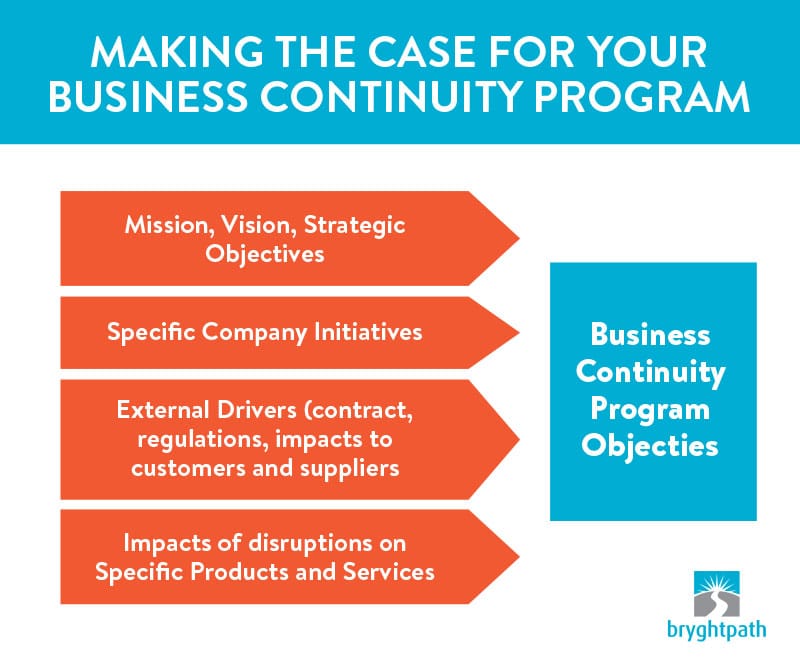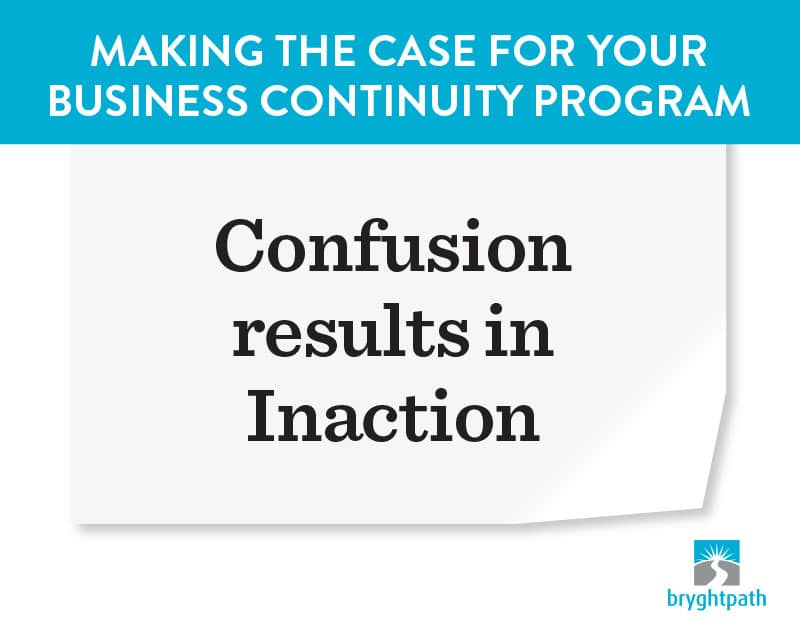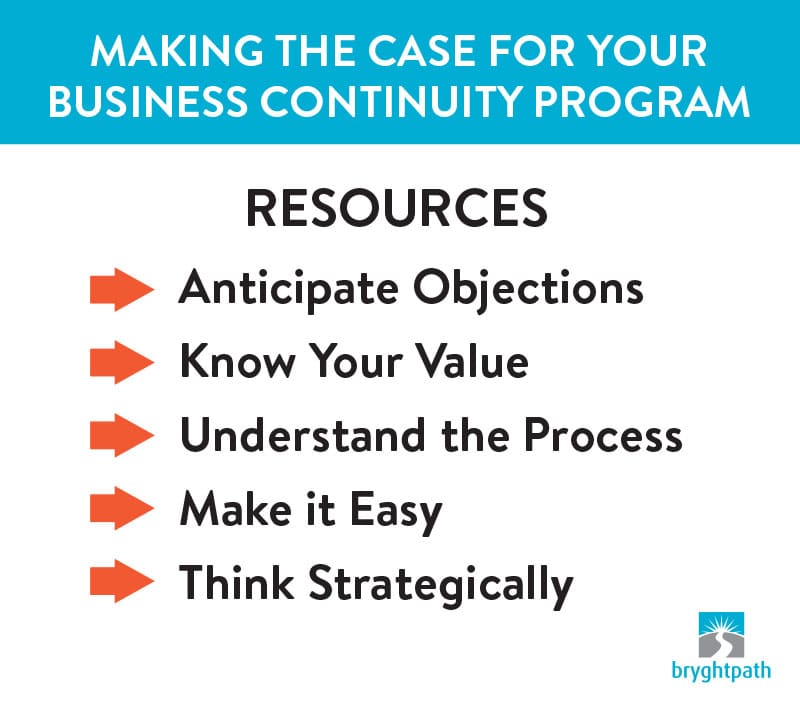Covid 19. Wildfires. Heatwaves. Floods.
It’s no wonder that by 2025, 70% of CEOs are predicted to place organizational resilience as a top priority for their organization’s strategic objectives.
With resiliency thrust into the limelight, many business continuity professionals may see their next step to sit back and wait for the budget money to rain down on their program.
That wait might take longer than they expect.
As a passionate business continuity consultant, I can’t deny that it excites me to see our profession gain a new level of visibility and traction. But having spent my time in the trenches of corporate America, I know that there is a lot of work to be done to get from global “resiliency mandate” to building a business ecosystem that is prepared to respond to tomorrow’s next disaster.
A lot of that work centers around convincing the people at the top, your c-suite executives and board of directors, to invest where it’s needed.
Your board knows what they want strategically, but are they ready to make the spend?
As a business continuity leader in your organization, it’s your job to help them bridge the gap from aspiration to action.
Here’s how to do exactly that.
Shift Your Perspective
Talk to any marketer and they’ll tell you the key to making the sale is getting deep into the mind of your target audience.
- What keeps them up at night?
- What particular challenges and concerns are facing them at this moment?
- If they could press an “easy” button what would it do?
Answer these questions, and you’ll have the insight you need to perfectly position your product or service as the answer to their woes.
It’s no different when it comes to selling your business continuity program to the executive leaders in your organization.
The first step to getting buy-in for your business continuity program is ensuring that it ladders up to the organization’s overall business objectives.
- Do you understand your company’s mission, vision, strategic objectives?
- What specific initiatives are important to your company right now?
- What are the external drivers—contracts, regulatory requirements, impacts to customers and suppliers—that most influence your operations?
- What products and services are you trying to protect and what are the likely impacts of a disruption to their delivery?
As the BCP subject matter expert, it’s easy to get caught up in the nuances of your work and fail to appreciate the big picture. By engaging with other stakeholders in your organization to understand the particular risks and vulnerabilities they are facing, you can grow your perspective to better align your BCP efforts with the business’s overarching objectives.
Position Your Ask
1. Anticipate Objections
There are rarely quantifiable benefits, from a revenue or cost standpoint, to investing in a quality business continuity program. And the competing needs of revenue-generating activities only add to the difficulty in securing resources for your business continuity program. That’s why many business continuity professionals may find their pitch shut down with the likes of:
- Why invest in business continuity versus a revenue generating capability or technology?
- Why do we even need to do this?
- How will this help us achieve our strategic objectives as an organization?
- How does this help our bottom line?
And my personal favorite:
What’s the chance of this really happening? Do we REALLY need to prepare for this?
These objections are all understandable. Why should your board invest $3 million preparing for something that might never happen when they could invest that same $3 million elsewhere and obtain a tangible return on investment?
These are hard objections to overcome.
But it can be done.
This brings me to my next point…
2. Know Your Value
While most senior leaders understand that organizational resilience is improved by a quality business continuity program, they may not appreciate its value at a more granular level.
But there are unique ways to demonstrate a tangible return on investment in your business continuity program.
Quantitative—What are the direct financial benefits of your BCP investment? Cost avoidance is one example; perhaps by leveraging new continuity planning technology you might show a 15% reduction in annual expenses while also improving organizational resilience.
Qualitative—If your company is spendy with its marketing, they well understand the importance of reputation and brand to their bottom line. That reputation, and the resources poured into building it, are all at stake at the hands of a PR-worthy disruption. Connect the dots between the two to make a stronger case for your BCP investment.
Benchmarking Progress—If you don’t already have a process and related metrics for evaluating your business continuity program, now is the time to start. Do you have the insights you need to understand:
- The overall maturity of your business continuity program?
- Whether your BCP is improving over time and in what particular areas?
- How does your business continuity program compare to your industry peers?
Having a proven system for tracking your company’s business continuity program will help chart your progress, and demonstrate your value to others.
Other intangible benefits of a good BCP program are also often underestimated. The business continuity planning process can improve transparency and communication among teams and strengthen your organization’s ability to respond proactively and creatively to emergent situations. Dig deep with your business continuity team to discover the overlooked benefits that will help you quantify the value of your program to others.
Want to learn more about Business Continuity?
Our Ultimate Guide to Business Continuity contains everything you need to know about business continuity.
You’ll learn what it is, why it’s important to your organization, how to develop a business continuity program, how to establish roles & responsibilities for your program, how to get buy-in from your executives, how to execute your Business Impact Analysis (BIA) and Business Continuity Plans, and how to integrate with your Crisis Management strategy.
We’ll also provide some perspectives on how to get help with your program and where to go to learn more about Business Continuity.
3. Understand the Process
Every company has its own unique culture and unspoken set of rules that inform the communication process between business unit leaders and senior and executive-level management. Before painstakingly preparing your pitch, it’s important to understand exactly how the process works in your particular organization.
Talk with other leaders who have been there, and preferably who have also been successful, to learn how to navigate the budget proposal process. Learn from their successes, avoid their mistakes, and seek their guidance when you encounter particular roadblocks.
4. Make it Easy
As the subject matter expert, it’s natural to want to use field-specific terminology—BIA, BCP, Maximum Tolerable Downtime, etc.—or to want to drill down into the graphic details behind your program proposal.
But the executive team you’re pitching aren’t experts in business continuity nor do they understand your jargon.
In the end, confusion results in inaction.
If you want to get to “yes,” you have to make it easy for your board and executives to understand the available options and the next step that you are asking them to take.
5. Think Strategically
Even the most experienced business continuity leader can fail to get the resources they ask for.
Sometimes it’s just a case of bad timing.
But more often it’s because the business continuity program may not be well perceived within your company. As the leader of your business continuity program, are you perceived as a business partner or some annoying person that comes around once a year and tells everyone to update their business continuity plan?
Taking small steps over time to improve your credibility within the organization will improve your chances of success come budget time.
And of course, there’s no better way to raise your credibility among your peers than by making the case for a business continuity investment before the inevitable power outage, flood, wildfire, or cyberattack actually happens.
“If only we had invested in those backup servers that you requested funding for last year.”
That’s a hard argument to overcome the next time business continuity comes up as a line item consideration.
Understand your value, know how to communicate it, and always be prepared to take advantage of the chaos when the next “BOOM” occurs.
Conclusion
As a business continuity expert in your organization, you know the value of your program but you might not yet know how to “sell it” to others.
In the end, executives want a business continuity program that is aligned to strategic objectives, saves money and time, and proactively mitigates risk. If you want their support, you need to understand their perspective and align your business continuity program to company-wide objectives.
Bryghtpath can help you make your case. Learn more about our approach to Business Continuity in our Ultimate Guide to Business Continuity and then contact us today.





 10 Tips for framing your case for Business Continuity to Executives
10 Tips for framing your case for Business Continuity to Executives